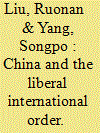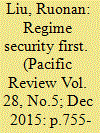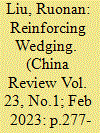|
|
|
Sort Order |
|
|
|
Items / Page
|
|
|
|
|
|
|
| Srl | Item |
| 1 |
ID:
191735


|
|
|
|
|
| Summary/Abstract |
How can we make sense of China's perceptions of and relationship with the liberal international order (LIO)? The majority of notable works on this topic have been written by foreign scholars who emphasize China's discontent with, or challenges it poses to, the LIO, while Chinese scholars have either focused solely on academic debates or attempted to interpret official foreign policies. This article aims to provide a balanced analysis of China's view of order by examining theoretical thought and policy practices from a Chinese perspective, drawing insights from both Chinese academic writings and government statements. We argue that there exists a perceptual difference between China and the West in understanding the postwar international order, with China emphasizing the functional part of the order and the West regarding it as based on its preferred ideological values. This perceptual difference has caused international suspicion about China's potential intentions to overthrow the LIO. In practice, China's approach has remained pragmatic, interacting dynamically with different subcomponents of the LIO. Although China's recent interactions with the LIO appear more ambitious, internal and external constraints, insufficient capacity, and lack of universally appealing values are preventing the birth of a Chinese version of international order.
|
|
|
|
|
|
|
|
|
|
|
|
|
|
|
|
| 2 |
ID:
168511


|
|
|
|
|
| Summary/Abstract |
A dualistic-order thesis has been emerged as a widely-used concept to describe East Asia’s regional dynamics. According to the thesis, the economic and security spheres of the region have become divorced from one other, whereby China and the United States dominate the economic and security realms, respectively. This paper demonstrates the deficiencies of this thesis, based on a comprehensive assessment of the economic and security developments in the region, as well as the strategic choices of small and middle regional powers. In order to form a more accurate and systematic understanding of regional prosperity and stability, this paper develops an economy-security nexus approach by integrating the interactions of regional actors in both the economic and security realms into a unified framework. From this perspective, East Asian regional order is sustained by a delicate coupling of regional economic and security configurations: ‘hot economics’ is accompanied with cooperative security interactions. Although China and the United States are not the dominant actors in either field, their relatively benign interactions in both realms collectively play a significant role by shaping the strategic environment for regional actors, allowing them to enjoy a large degree of strategic flexibility and increase their security and prosperity.
|
|
|
|
|
|
|
|
|
|
|
|
|
|
|
|
| 3 |
ID:
141149


|
|
|
|
|
| Summary/Abstract |
China's rise in recent years has exacerbated Vietnam–China security tensions over maritime disputes in the South China Sea. To manage its security competition with China, Vietnam has simultaneously improved its security cooperation with the United States while maintaining a safe distance from it, in efforts to reassure China. This article attempts to explore the dynamics of the Vietnam's security policy towards the United States and China in the Post-Cold War era. The authors find that the combinations of Vietnam's Post-Cold War security policy towards the United States and China are shaped by its concerns over regime security with respect to the primary threats of infiltration by US democratic norms and of excessive anti-Chinese nationalism. The relative levels of both these risks lead to various combinations of Vietnam's security policies vis-à-vis the United States and China.
|
|
|
|
|
|
|
|
|
|
|
|
|
|
|
|
| 4 |
ID:
189328


|
|
|
|
|
| Summary/Abstract |
From the Asian financial crisis in 1997 to the year 2010, China's self-restraint and strategic reassurance toward ASEAN countries created a favorable regional environment for its rise. After 2010, the South China Sea disputes and the Sino-U.S. strategic competition intensified. During this period, China simultaneously pursue a wedging strategy which aims to avoid Southeast Asia completely turning toward the United States. Since the Trump administration launched the Indo-Pacific strategy, Sino-U.S. relations have transited from competition to confrontation, significantly increasing the importance of Southeast Asia as a buffer between China and the U.S. At the same time, intensified economic dependence on China for ASEAN countries, and the uncertainty surrounding the U.S.'s strategic attention to the region have increased the costs and risks of alienating China. Both China and ASEAN countries can no longer afford further deterioration in their relations. In the context of the Indo-Pacific strategy, the primary goal of China's Southeast Asia policy is to reduce ASEAN countries' willingness and ability to rely on external powers to exert pressure on it, while strengthening the region's function as a bridge to the global industrial chain and undermining the legitimacy of the Indo-Pacific strategy through advocating ASEAN-led multilateralism. China's Southeast Asia policy effectiveness depends on Beijing's ability to alleviate the internal dilemma within its policy goal, which has been intensified by the Indo-Pacific Strategy. Currently, the Indo-Pacific Strategy has gained some support in Southeast Asia and has weakened the regional countries' domestic support for pro-China policy. Future challenges in China's relations with ASEAN countries do not depend exclusively on the dynamics of the Sino-U.S. relations, given that domestic political changes in key regional countries are closely tied to China's relations with the region.
|
|
|
|
|
|
|
|
|
|
|
|
|
|
|
|
|
|
|
|
|